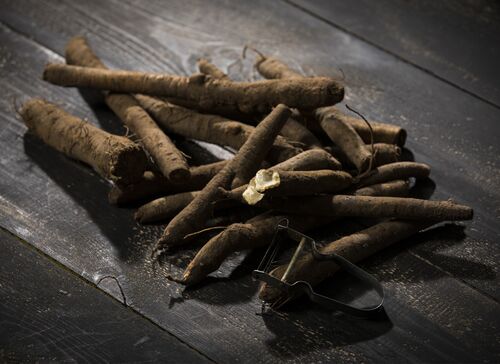Growing and Sowing Scorzonera

Scorzenera hispanica, also known as black salsify, winter asparagus and asparagus of the poor man, are long, dark roots. The vegetable is very difficult to clean. It is a hardy vegetable and can be harvested all winter from September onwards. It is important that the soil is not frozen, because then they cannot be removed from the ground. The taste of salsify is somewhat bitter, spicy and nutty and is reminiscent of that of asparagus.
Growing your own scorzonera from seeds
Scorzonera belongs to the composite family. It is a root vegetable that needs quite a long time to grow. Harvesting can be done, starting in September, practically throughout the winter. Apart from the root, the young leaves are also edible. There are many species of salsify, the large salsify (Scorzonera Hispanica) being the root vegetable known to us. This is basically a perennial plant that makes a taproot in the first year and starts flowering in the second year. But of course, it does not make it to that second year when it is harvested.
Direct to the Scorzonera Seeds >
Sowing and planting scorzonera
From mid-April to mid-May, scorzonera can be sown in the open ground. Make sure the soil is loose before sowing to get a nice straight taproot. Pre-sowing is not recommended because the plant is difficult to transplant due to its long taproot. You can sow earlier, but this increases the chance that the plant will flower. The roots are still edible, but develop more poorly. Sow in rows with a row spacing of about 25 cm and place a seed every 5 cm. If necessary, thin out later at a planting distance of about 10 cm. You can also sow in pots, but make sure the pots are high enough.
Position and soil
Scorzonera likes a sunny or semi-shaded spot in the vegetable garden. The soil should be airy; clay soil is unsuitable. They grow best in sandy soil. If necessary, the (clay) soil can be improved using compost and crushing sand.
How to care of your scorzonera plants
The scorzonera is very easy to care for. Keep the soil around the plant weed-free and water it in warm, dry weather. Fertilising is not necessary. Scorzonera develops thicker roots if watered regularly. Should the plant start to flower, remove the flower stem as soon as possible.
When and how to harvest scorzonera ?
Harvesting is possible from September onwards. The roots are then about 3 to 4 cm thick and can be quite long, 30 cm or more. Harvest carefully and loosen the soil around the root well, as the roots break very quickly. This can be done, for example, by digging a trench along the roots, or loosening the soil with a pitchfork. Scorzonera is hardy and can be harvested until early March. However, bear frost in mind, because then they are obviously impossible to get out of the ground.
How to preserve scorzonera
If stored in a cool and dry place, scorzonera can be kept for a few weeks. They can also be frozen, peel and blanch first.
Is scorzonera healthy?
Scorzonera is very healthy. They are high in fiber, vitamin C and minerals such as phosphorus, calcium, iron, potassium and magnesium. Compared to other vegetables, they contain a bit more kcal.
Scorzonera seeds in our collection
In our range we have different types of scorzonera, including an organic variant.
Tips to grow scorzonera
- Put on gloves when cleaning scorzonera. This is because they have sticky milk juice, which is very difficult to wash off your hands. Peel them using a peeler.
- To prevent the scorzonera from turning brown after peeling, keep them in water with some vinegar or milk until they are going to be cooked.



